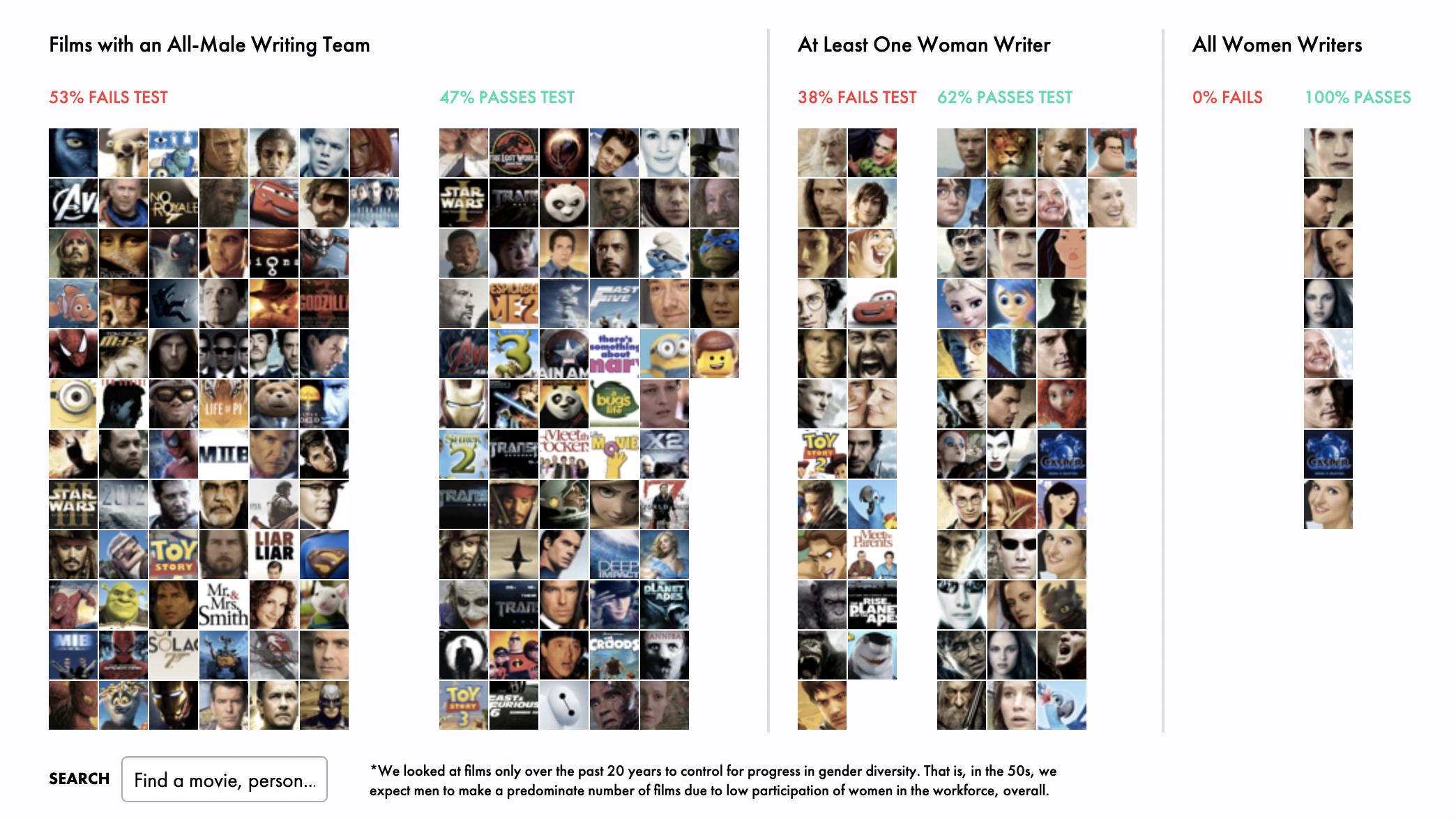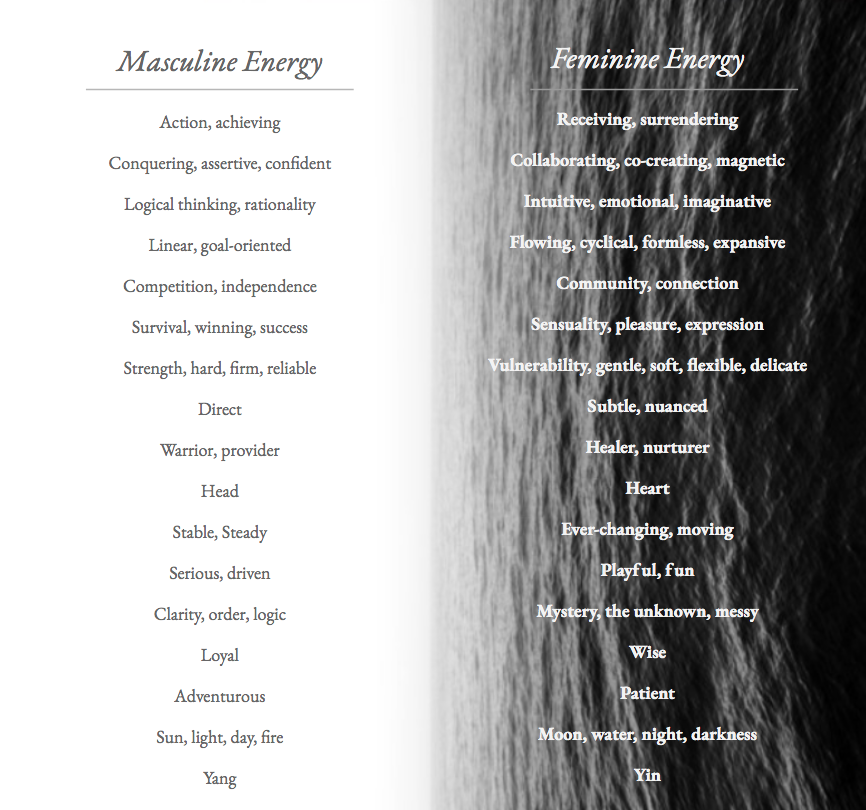Nurturing the feminine
Each of us has a feminine and a masculine energy or side of ourselves. For most of us, in our era, our masculine sides have been celebrated as best, most valuable, and most powerful, while our feminine sides have been devalued, stifled, muted, and left out.
We will not find wholeness or flourishing as individuals or as a collective until we find equality and balance between the masculine and the feminine.
“Toxic masculinity” is not saying that masculinity itself is toxic. It’s pointing to an imbalance where the masculine energy is overpowering the feminine presence to an unhealthy degree.
We observe that imbalance in our world today and want to lean into the “feminine” way/presence in ourselves and in leadership for a while in order to restore some measure of balance.
“When women are the storytellers, the human story changes.” — Elizabeth Lesser
Females In Film
Let’s start by looking at females in film. Mostly because it’s a helpful mirror/creator of our culture and because we have great data on it now.
Some eye-opening quick facts:
Women account for 50% of moviegoers. (MPA 2019)
YET…
Of the top 100 grossing films of 2019, women represented 10.7% of directors, 19.4% of writers, and 24.3% of producers. (Inclusion Initiative)
- female
- male
- female
- male
- female
- San Francisco
- female
- San Francisco
- female
- male
- female
- male
Only two women have ever won the Academy Award for Best Director. Only seven women have ever been nominated.
68% of those who vote on the Academy Awards are men. (source)
43 of 2019’s top 100 films featured a female lead or co-lead. (Inclusion Initiative)
68% of all female characters were white in the top 100 films of 2019. 20% were Black, 7% were Asian, and 5% were Latina. (Center for the Study of Women in Television and Film)
The overwhelming majority of talk time is dominated by male voices:
And in Disney movies…
Where do girls and boys learn their roles in the world?
“In January 2016, researchers reported that men speak more often than women in Disney’s princess films. We validated this claim and doubled the sample size to 30 Disney films, including Pixar. The results: 22 of 30 Disney films have a male majority of dialogue. Even films with female leads, such as Mulan, the dialogue swings male. Mushu, her protector dragon, has 50% more words of dialogue than Mulan herself.” (source)
And lastly, there’s the pitifully low bar called the Bechdel Test. A film passes the Bechdel Test if it features:
At least two named female characters…
Who talk to each other…
About something other than a man.
Even films like Toy Story, Avatar, Harry Potter, and What Women Want fail. Ouch.
Now we are developing more tests that raise the bar for inclusion…
source (though we edited the graphic to show the top 10 grossing films)
For a closer study of women in film, if you have the time, we highly recommend watching the documentary, This Changes Everything (on Netflix).
Well, what about females in other sectors?
Women in placemaking
“Take a moment to look around you. Really look. See the city — the streets, the buildings, the spaces between them — and realize for a moment that virtually everything you see has been designed and shaped by men.” source
“All over the world, the built-environment professions — and particularly their uppermost echelons — remain heavily male-dominated, more so than other spheres such as education or health.” source
Sadly, it’s kinda the same story nearly everywhere we look.
We’ve gotten a pretty good idea of what (white) manmade built environments look like.
How would womanmade and marginalized people design a community?
(Note: spellcheck says womanmade isn’t a real word.)
What do we even mean by “the feminine”?
The lists above are a compilation of the generalized cultural and literary understanding of the masculine and feminine, yin and yang forces described in many traditions.
Again, we all have each side within us and the goal is to become more balanced and able to choose how you want and need to show up in each moment.
Take a few moments to look over the lists above again and consider how our built environments reflect each side (or don’t). What it would take to achieve balance?
How do we achieve balance?
Internally
For a while, we need to intentionally nurture, develop, and platform the feminine energy within our own selves. Learn to value this other perspective and identify the patriarchal and sexist beliefs we have (male and females) absorbed and begin to root it out in our own selves.
Collectively
At the same time, we need to look at the leadership of our own organizations and make intentional changes to include women’s voices and perspectives not just at the table, but in real positions of power.
Harvard Law shared a study by Russell Reynolds Associates on how to foster change in Diversity & Inclusion in big businesses. They concluded that it must start with the Board Chair and include a strong partnership with the CEO.
“The obvious—and often uncomfortable—starting point is to take stock of how visibly diverse a board is.
To be effective, the group has to attain a critical mass of diverse viewpoints rather than simply including a symbolic woman or other minority representative. “My own experience is that when you are a lone female on a board, you are seen as a female voice. Once you reach a critical mass of three or more female directors, you are just seen as a voice; gender is no longer a factor,” said Nancy McKinstry, CEO and executive board chairman, Wolters Kluwer NV.”
Summary
This era of history is woefully, dangerously, skewed toward the masculine.
Healing, personal and collective, will evade us until we can equally value the masculine and feminine perspectives.
We are eager to lean—perhaps even uncomfortably far for a while—into the feminine perspective in order to regain balance.
We recognize that we are currently underdeveloped in our feminine side and want to really nourish the feminine in us and in our organizations until we catch our balance better.
We want to see what goodness will emerge when we give the mic and the keys and the director’s chair to the dreams of those who we haven’t heard much from in a long long while.









